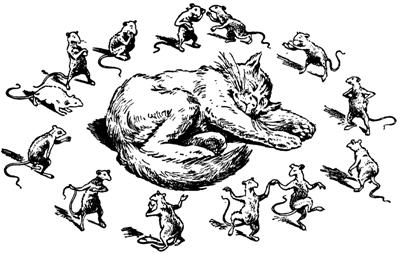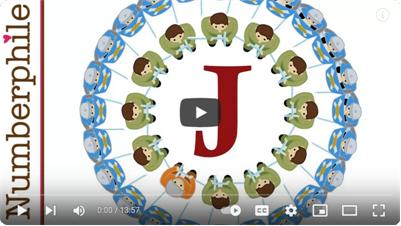 This is a classic puzzle from Boris Kordemsky’s 1972 Moscow Puzzles.
This is a classic puzzle from Boris Kordemsky’s 1972 Moscow Puzzles.
“Purrer has decided to take a nap. He dreams he is encircled by 13 mice: 12 gray and 1 white. He hears his owner saying: “Purrer, you are to eat each thirteenth mouse, keeping the same direction. The last mouse you eat must be the white one.” Which mouse should he start from [eat first]?”
See Cat and Mice for a solution.
The Josephus Problem
 This famous Josephus Problem presented on Youtube is somewhat different from the Cat and Mice puzzle, but still has similarities. An article by Jay Bennett discussing the problem was published in Popular Mechanics in 2016.
This famous Josephus Problem presented on Youtube is somewhat different from the Cat and Mice puzzle, but still has similarities. An article by Jay Bennett discussing the problem was published in Popular Mechanics in 2016.
Penn and Teller – Spelling Cards
 It turns out that Penn and Teller have performed another magic trick recently that is based on mathematical principles and so is more or less self-working. It is a more complicated version of the Cat and Mice puzzle, which I have dubbed the “Spelling Cards” trick.
It turns out that Penn and Teller have performed another magic trick recently that is based on mathematical principles and so is more or less self-working. It is a more complicated version of the Cat and Mice puzzle, which I have dubbed the “Spelling Cards” trick.
What follows is a detailed narration of the trick. But it is easier and more fun to watch the video.
Characters Piff, Pop (Penn), and Squire (Teller), along with Brook carry out the trick. Piff shows 10 cards and then holding them face down asks Brook to name the most important card, and she says an ace. So Piff begins counting 3 cards for each letter in the name of the card. As he removes each face-down card from the top of the pack, he puts it on the bottom. After placing the third face-down card on the bottom, he turns the next card face up and shows it to be the ace of clubs. He tosses it away.
Next Penn takes the pack and counts off 3 cards for “dos” (two) and turns over the next card on top. It is a two of hearts, which he then tosses away. Now it is Teller’s turn and he counts off 5 cards for “three” and shows a three of spades. He tosses that away. Finally Brook takes the pack and counts off 4 cards for “four” and turns over the next card. But it is the ten of diamonds! Oops. So Brook puts the ten back on the pack and hands it to Piff.
Piff again counts 4 cards and turns over the next revealing the four of clubs, which gets tossed. Penn counts off 4 cards for “five” and turns over the 5 of hearts, and that gets tossed. Brook counts off 3 cards for “six”, but again turns over the ten of diamonds. She puts it back on the stack, and Teller has a go. He counts off 3 cards again and turns over the six of hearts, which he tosses.
Brook tries again and counts off 5 cards for “seven”, but again turns up the ten of diamonds. Returning the ten to the pack she gives it to Piff, who counts of 5 cards again and turns over the seven of spades. Piff tosses the card. Brook tries once more by counting off 5 cards for “eight”, but again turns over the ten of diamonds. Teller has a go and counting off 5 cards arrives at the eight of clubs, which he tosses. Frustrated Brook tries a final time and counts off 4 cards for “nine”. And of course she turns over the ten of diamonds again. Teller again takes the pack (watch the video carefully here) and counts the four cards turning over the nine of hearts, which he tosses. With only one card left, Teller gives it to Brook to “count” the card 3 times for “ten” to reveal again the ten of diamonds, but this time appropriately.
So the question is, what is the initial arrangement of the cards so that this trick will work automatically?
See the Spelling Cards trick for a solution.
